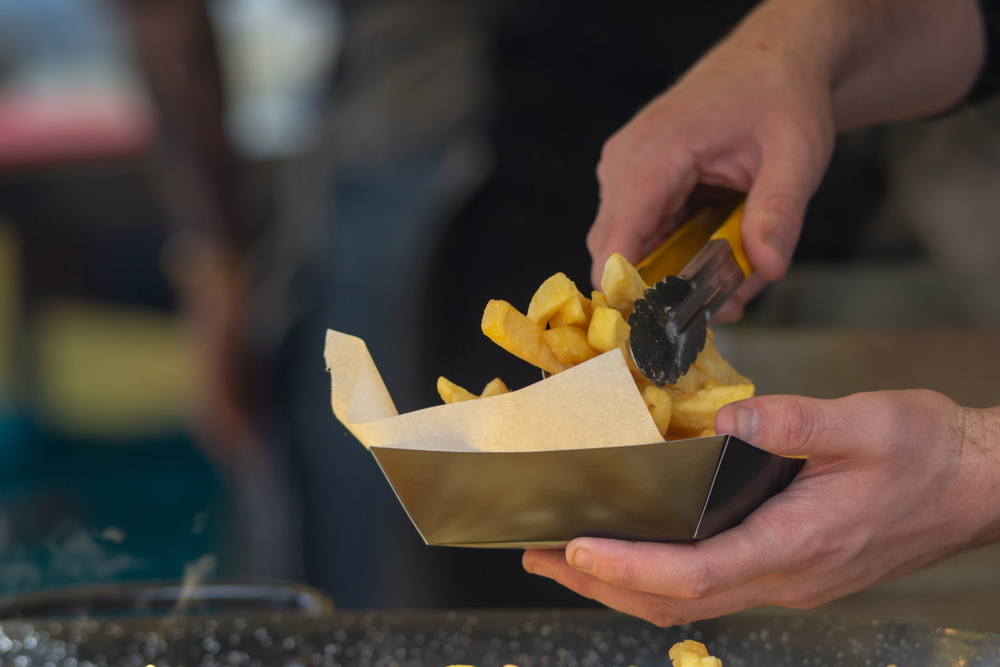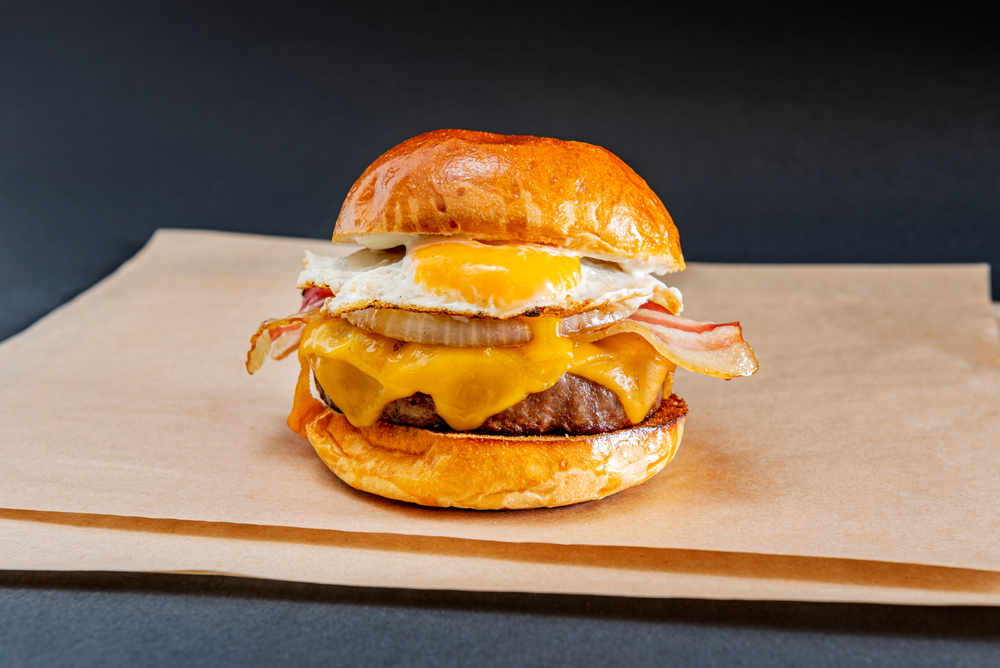Top Greaseproof Paper for Fish and Chips: Keep Your Meals Crisp
By Alysse Phily · 10. July 2024
Looking for the best greaseproof paper for fish and chips?
This guide explains why it’s essential, how it keeps your food crisp, and reviews the top options available.
Key Takeaways
- 🗝️ Greaseproof paper is essential for maintaining the crispiness and appearance of fish and chips by absorbing excess oil and keeping the food fresh during transport.
- 🗝️ Custom printed greaseproof paper offers branding opportunities for businesses and is available in both kraft and white options, enhancing the professional look and eco-friendly image of the packaging.
- 🗝️ Eco-friendly greaseproof paper options, such as natural and unprinted sheets, are biodegradable, compostable, and recyclable, supporting sustainability while ensuring food remains intact and the wrapping effective against oils and grease.
The Importance of Greaseproof Paper for Fish and Chips
 man serving fish and chips on a greaseproof paper
man serving fish and chips on a greaseproof paper
Greaseproof paper, the unsung hero behind every crispy bite of fish and chips, plays a key role in absorbing excess oil to maintain the food’s crispiness.
Without it, the fish and chips would quickly become soggy, losing its delightful texture and appeal.
Moreover, greaseproof paper can:
- Ensure that the food remains fresh during transport
- Aid in preserving the food’s prime condition until it reaches the consumer
- Extend beyond simply absorbing oil – it’s about upholding the meal’s integrity
The versatility of greaseproof paper can’t be overstated. It can handle heavy oils and is ideal for a range of food items, enhancing both the appearance and flavour of the meal. When it comes to fish and chips, presentation is key.
A clean, appealing wrap can elevate the dining experience, making the food look as good as it tastes.
Printed Greaseproof Paper Options
🖼️ Offering a blend of functionality and branding, printed greaseproof paper is an excellent choice.
Custom printed options allow businesses to have their logos and designs imprinted on the paper, which can significantly enhance brand recognition.
Starting from as little as 1000 sheets, even small businesses can take advantage of this opportunity.
These custom prints are not limited to one type of paper. Both kraft and white natural greaseproof paper sheets can be used, providing a sustainable yet stylish option for food wrapping.
This not only helps in branding but also conveys a message of eco-friendliness, which is increasingly important to consumers today.
Printed greaseproof paper is versatile, suitable for wrapping a variety of food items like fries, burgers, and sandwiches.
It adds a professional touch to the packaging, making it look more appealing and enhancing the overall dining experience.
Natural Greaseproof Paper Sheets
For those conscious of reducing their environmental footprint, natural greaseproof paper sheets are an outstanding eco-friendly alternative.
These sheets are biodegradable and compostable, making them a sustainable option for wrapping fish and chips, or even lining a basket for serving.
Produced from 100% virgin pulp and often classified as wood-free, natural greaseproof paper aligns with the growing demand for environmentally responsible products.
Many eco-friendly fish and chips packaging solutions use plant-based materials that break down naturally, reducing the impact on landfills.
Despite their eco-friendly nature, these sheets are treated to resist the penetration of grease and oils, ensuring that the food stays intact and the wrapping doesn’t degrade. This makes them both a practical and a responsible choice for food service.
Unprinted Brown Greaseproof Paper Sheets
 burger on greaseproof paper
burger on greaseproof paper
Yet another eco-friendly alternative is the use of unprinted brown greaseproof paper sheets. These sheets are 100% biodegradable and recyclable, which means they can be disposed of without harming the planet.
Available in packs of 1000, these sheets offer a cost-effective solution for businesses that need to buy in bulk.
This bulk packaging makes them an economical choice, perfect for those looking to keep costs down while still providing high-quality packaging and maintaining a sufficient quantity.
Using unprinted brown greaseproof paper sheets doesn’t just save money; it also projects an image of sustainability and responsibility, which can be a significant selling point for eco-conscious customers.
Unprinted White Greaseproof Paper Sheets
 woman putting greaseproof paper in baking pan
woman putting greaseproof paper in baking pan
Wrapping greasy foods like fish and chips can be economically and versatile done using unprinted white greaseproof paper sheets.
These sheets are designed to handle the oils and greases that come with fried foods, ensuring that the food remains crisp and fresh.
They are also environmentally friendly, aligning with the sustainable practices that many businesses and consumers are now adopting.
The competitive pricing of these sheets makes them an attractive option for businesses that need to balance cost and quality.
By choosing unprinted white greaseproof paper sheets, businesses can provide a clean and professional look without compromising on their eco-friendly values.
Custom Printed Greaseproof Paper
Enhancing food presentation and boosting brand recognition is achievable using custom printed greaseproof paper.
You can find both white and brown natural greaseproof paper options, allowing you to choose the one that best fits your brand image.
Having a business logo or design printed on the greaseproof paper can:
- Significantly enhance brand visibility
- Create a memorable dining experience for customers
- Help in marketing
- Add a touch of professionalism and elegance to the food presentation.
Whether you choose white or brown, custom printed greaseproof paper can make a significant difference in how your food is perceived by customers.
Standard Sheet Sizes for Fish and Chips
Choosing the appropriate sheet size of greaseproof paper for fish and chips in a box is a significant consideration.
Common sizes include 250mm x 375mm, 300mm x 400mm, and 375mm x 500mm, with each size serving different portions.
Using the appropriate sheet size not only enhances the presentation but also helps in minimising waste by ensuring that there is no excess paper used.
This can significantly impact the overall efficiency and cost-effectiveness of your food service operations.
Buying Options and Pricing
Bulk purchasing options often provide cost savings per sheet compared to buying smaller packs, making them an economical choice for larger businesses.
Additionally, some suppliers offer subscribe-and-save options, allowing businesses to receive regular shipments of greaseproof paper at discounted rates.
Delivery charges can vary based on location, but many suppliers offer international shipping, ensuring that businesses worldwide can access high-quality greaseproof paper.
Features and Benefits of Using Greaseproof Paper
 © Limepack Greaseproof Paper for packing burger
© Limepack Greaseproof Paper for packing burger
Greaseproof paper is an indispensable tool in the food industry. It prevents food from becoming soggy or greasy, which is crucial for maintaining the quality and appeal of dishes like fish and chips.
When used in takeaway, greaseproof paper helps keep food fresh and prevents grease stains and leaks, ensuring a clean and pleasant dining experience for customers.
Its versatility extends beyond fish and chips, making it suitable for wraps, burgers, and other grease-heavy foods.
Greaseproof paper can also be used as tray liners or placements due to its grease-resistant quality, adding to its functionality.
By providing a professional look, being recyclable, and offering premium packaging, greaseproof paper is a cost-effective and environmentally friendly option for businesses.
Environmentally Friendly Choices
Opting for eco-friendly greaseproof paper offers several benefits:
- It contributes towards waste reduction and supports sustainability efforts.
- Traditional packaging materials like polystyrene take hundreds of years to decompose, causing significant environmental harm.
- In contrast, eco-friendly greaseproof paper options are biodegradable and compostable, breaking down naturally without leaving harmful residues.
This not only reduces waste but also aligns with the growing consumer demand for environmentally responsible products.
Using sustainable materials in greaseproof paper, such as those certified by the Forest Stewardship Council (FSC), adds an extra layer of eco-friendliness.
These materials are recyclable, promoting a circular economy by allowing the paper to be reused and repurposed.
Summary
In summary, greaseproof paper is essential for keeping fish and chips crisp and fresh.
Whether you choose printed or unprinted, brown or white, each type of greaseproof paper offers unique benefits that can significantly enhance food presentation and sustainability.
Making informed choices about greaseproof paper not only improves the quality of your food but also aligns with eco-friendly practices that are increasingly important to consumers.
By opting for sustainable packaging, you can reduce waste, support environmental efforts, and meet the growing demand for responsible products.
Frequently Asked Questions
Why is greaseproof paper essential for fish and chips?
Greaseproof paper is essential for fish and chips because it absorbs excess oil, keeping the food crisp and preventing it from becoming soggy, maintaining its fresh quality during transport.
What are the benefits of custom printed greaseproof paper?
Custom printed greaseproof paper can enhance brand recognition through customised logos and designs, while also adding a professional touch to food presentation. Additionally, it can be made from eco-friendly materials.
How is natural greaseproof paper eco-friendly?
Greaseproof paper is eco-friendly because it is biodegradable, compostable, and made from 100% virgin pulp and plant-based materials, contributing to environmental sustainability.
What are the standard sheet sizes for fish and chips?
The standard sheet sizes for fish and chips range from 250mm x 375mm for single portions to 375mm x 500mm for family-sized servings, supporting proper food presentation and minimising waste.

